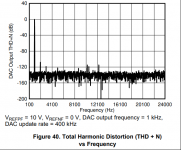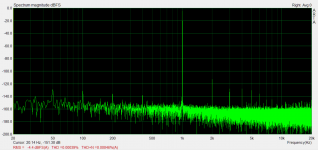Sorry if this is a silly question, but... will the QA402 finally work USB audio device? This would open up soooo many possibilities! Just think of all the software that could be used with it...
Are the ESS DACs OK up to some 80+kHz for the 192kHz samplerate? I have not seen any measurements above 25kHz.
The OPA1656 is a designer's wet dream 😱
Jan
I think that's the best complement one of my audio op amps has ever received.
The PCM1794 is good enough for a listening DAC, but not for a measurement device. Some PCM1794a issues:
PCM1794A left/right channel distortion difference – nihtila.com
PCM1794A left/right channel distortion difference – nihtila.com
Last edited:
Some time ago LM4562 and LME49860 (and the whole series) were the top (imho), but now those OPAs (and their sisters or brothers, the whole new series) seem the best. (and much more EMF resistant etc - it is important property now too).I think that's the best complement one of my audio op amps has ever received.

Last edited:
Sorry if this is a silly question, but... will the QA402 finally work USB audio device? This would open up soooo many possibilities! Just think of all the software that could be used with it...
Have you looked at this?
GitHub - dechamps/ASIO401: An unofficial ASIO driver for the QuantAsylum QA401 audio analyzer.
This is ASIO only, Windows only. I am looking for USB Audio Class so it would just work on any modern operating system.
The PCM1794 is good enough for a listening DAC, but not for a measurement device. Some PCM1794a issues:
PCM1794A left/right channel distortion difference – nihtila.com
I don't think so. First, the "issue" is within spec limits according to the writer. Second, these are all the observations of one person and their own designs. It could be their design or measurement setup.
I have no doubt that Matt has done all the testing he needs to put it in his product with confidence.
Last edited:
This is ASIO only, Windows only. I am looking for USB Audio Class so it would just work on any modern operating system.
With ASIO driver for QA401, I am able to use QA401 as a audio DAC, playback is possible just like any audio DACs.
That's one of the reason I suggests ES9038Q2M instead of PCM1794, because 9038s are good sounding, a bit better performance, nearly the same cost compared with PCM1794.
People nowadays are doing more 9038-related projects more than PCM1794's.
I know there's project DDDAC1794 and some other, but we can see more that uses 90X8s.
If it has to be TI's, how about DAC11001A with low noise and THD, R-2R-based? The THD performance in the datasheet looks good and covers at least 24KHz BW.
Attachments
ESS isn't bigger than AKM as far as I know, and doesn't have the track record of a TI or AD where you can still buy parts that are older than some of the interns at my office.
There are caveats to that DAC; it will require glue to interface with, requires an external digital filter, and it seems like the distortion vs frequency is rising in the audio band more than most audio converters based on the posts in the thread on that DAC. That DAC is good for applications where DC precision and linearity are important.
There are caveats to that DAC; it will require glue to interface with, requires an external digital filter, and it seems like the distortion vs frequency is rising in the audio band more than most audio converters based on the posts in the thread on that DAC. That DAC is good for applications where DC precision and linearity are important.
Last edited:
With ASIO driver for QA401, I am able to use QA401 as a audio DAC, playback is possible just like any audio DACs.
So you're running ASIO on Windows. That's not what my question was about. I am not interested in ASIO. I am not interested in Windows.
I am interested if the QA402 works as a USB Audio Class device to allow free choice of software.
It would require a lot of work on QA’s part. Right now I’m pretty sure they use a Cypress USB FIFO interface to send data and their API/driver to get it into their application. To make a USB Audio Class Device would require another IC plus supporting components and a bunch of switches or additional logic in a CPLD or FPGA.
The use of TI products is no surprise for a replacement unit. TI have superb customer service and have been the only semi conductor company who have gone above and beyond even to hobbyist enquiries (at least to mine).
ESS on the other hand? Cloak and dagger at every turn. With the dreaded 'ESS hump' and, as far as I can tell, no description of how to tune this out in their datasheets. Plus, from what I've seen, tuning the hump out is quite a delicate procedure the stability of which has yet to be seen. You might fine tune the hump out today, but in a years time? Maybe it would be fine but to need the I/V components to be tuned so precisely as to eliminate it? I just think of component drift and how the performance might degrade.
The ESS hump is a massive no-no when it comes to measurement style gear where using the DAC/ADC at several dBs back, to minimise distortion, is regularly employed. Turn the dial back on an ESS product, that hasn't had the hump tuned out, and distortion goes up. At least the TI part is a known quantity, with support.
No the 1792/4 doesn't reach quite the same distortion minima as the 4490 did but it's low enough for a lot of what you'd use the Q40x for.
My recent experience with revisiting the 1792 again? Two images are attached. I have no idea which is the left or right channel but both are done at 96kHz with the OS turned down to 32x as this does lower distortion. Effectively cutting it in half, or showing what the performance would be at 48kHz with 64x OS. 64x OS is the default for the 1792 and the only option on the 1794.
NE5534 for the I/V stage, NP0/C0G caps.
One channel does have more distortion than the other but as this was a project I wanted to get done, and then shipped, I was happy to leave things as they were. It's hitting spec, especially if you consider the noise will be even lower in reality as this is including the ADCs input noise.
When you drop the signal level down to around -20dBfs the distortion drops into the 0.0001/2% realm.
These chips have been available for years, are used in many products, and are unlikely to vanish from the market unexpectedly.
ESS on the other hand? Cloak and dagger at every turn. With the dreaded 'ESS hump' and, as far as I can tell, no description of how to tune this out in their datasheets. Plus, from what I've seen, tuning the hump out is quite a delicate procedure the stability of which has yet to be seen. You might fine tune the hump out today, but in a years time? Maybe it would be fine but to need the I/V components to be tuned so precisely as to eliminate it? I just think of component drift and how the performance might degrade.
The ESS hump is a massive no-no when it comes to measurement style gear where using the DAC/ADC at several dBs back, to minimise distortion, is regularly employed. Turn the dial back on an ESS product, that hasn't had the hump tuned out, and distortion goes up. At least the TI part is a known quantity, with support.
No the 1792/4 doesn't reach quite the same distortion minima as the 4490 did but it's low enough for a lot of what you'd use the Q40x for.
My recent experience with revisiting the 1792 again? Two images are attached. I have no idea which is the left or right channel but both are done at 96kHz with the OS turned down to 32x as this does lower distortion. Effectively cutting it in half, or showing what the performance would be at 48kHz with 64x OS. 64x OS is the default for the 1792 and the only option on the 1794.
NE5534 for the I/V stage, NP0/C0G caps.
One channel does have more distortion than the other but as this was a project I wanted to get done, and then shipped, I was happy to leave things as they were. It's hitting spec, especially if you consider the noise will be even lower in reality as this is including the ADCs input noise.
When you drop the signal level down to around -20dBfs the distortion drops into the 0.0001/2% realm.
These chips have been available for years, are used in many products, and are unlikely to vanish from the market unexpectedly.
Attachments
Your measurement shows about -110dB below H0 at the 1st harmonic. With an ESS it can easily reach -130dB.
diyralf: Please what does it show e.g. at 30kHz, as this is a measurement device? No such info available online, or I have missed it. Thanks a lot.
Your measurement shows about -110dB below H0 at the 1st harmonic. With an ESS it can easily reach -130dB.
I'm not denying that. I posted these measurements as a comparison to the ones posted above. Needless to say mine are somewhat better than the others.
For one channel yeah, the 2nd harmonic is at around -110dB, the other one is significantly better and you'd always use the better channel for measurements where you need the lowest distortion.
Yes the ESS parts can do better but like I said ESS aren't known as being easy to work with. The ESS hump destroys the performance of a measurement device. If ESS gave detailed instructions on how to eliminate it that would be one thing. But as far as I know they don't.
Lots of people/companies choose not to use ESS specifically because of the companies lack of transparency. Unlike TI who are only happy to throw information/development tools at you and whom are willing to pull out EVMs and run tests in conjunction with your product development.
If the design outline for the QA402 is to develop a product with very quick time to market, with robust supply chains and with similar capabilities to the QA401 then I'd go with TI too.
Could a different product be developed using an ESS DAC and the brand new ESS ADC? Yeah. Would that theoretically have better performance? Yeah. Would it be available anywhere near as soon? Absolutely not. That would be a different product, at a different price point.
Looking good, I also come to the same conclusions regarding ESS and other companies that are not forthcoming with information that the small performance advantages are not worth the risk.
- Home
- Design & Build
- Equipment & Tools
- QuantAsylum QA400 and QA401


